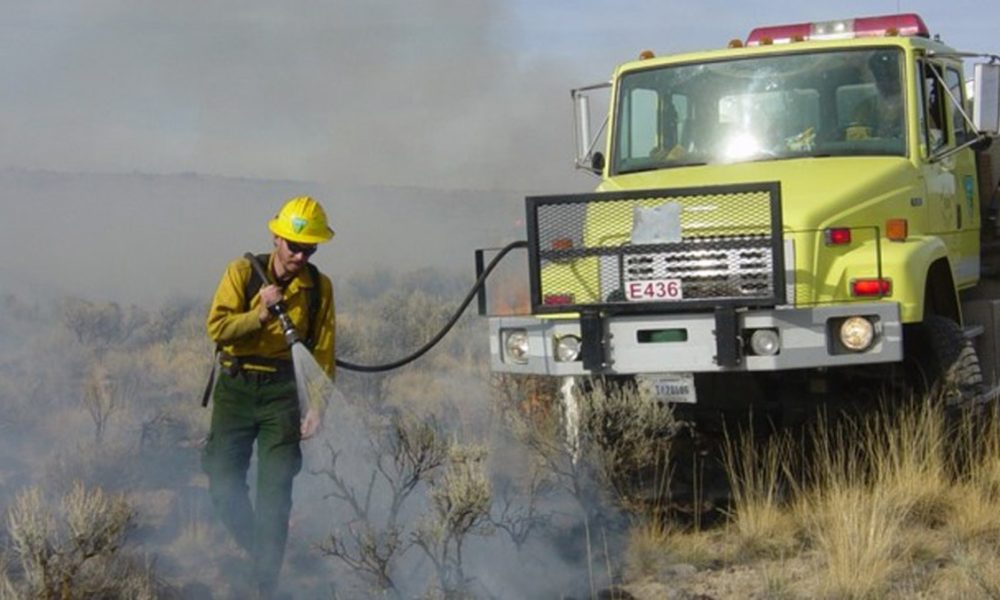 A BLM firefighter sprays down smoldering brush at the scene of a range fire in the season coming to an end. (File photo/BLM)
A BLM firefighter sprays down smoldering brush at the scene of a range fire in the season coming to an end. (File photo/BLM)
VALE – Mother Nature came through for the Vale District of the Bureau of Land Management this fire season.
Humans, though, didn’t show the same consideration during a fire season that fizzled rather than flared.
Fewer storms producing less lightning meant firefighters encountered a below average fire season in terms of total acres burned. Just over 15,000 acres burned on the Vale District, far below the 38,000 acres scorched in 2017.
“That is way below average,” said Al Crouch, the Vale District’s fire information officer.
However, fires started by people are on an upswing.
“Human-caused fire averages are up, above average and that trend is continuing,” said Crouch.
Crouch said he isn’t sure why human-caused blazes are rising.
“It’s hard to say. But there is no doubt we are seeing more recreation use on the district and, because of the nature of the road systems in eastern Oregon, we get a lot of traffic coming through here,” he said.
Bob Narus, the Vale BLM fire management officer, said humans sparked 18 fires this year. Last year, he said, 26 fires were caused by humans. The 10-year average for human-caused fires is 13.
Crouch said most human-caused fires are from vehicles.
“It could a flat tire on a rim,” said Crouch. “And, to no surprise, shooting is also becoming a leading cause of fires and we are above average in the number of shooting-caused fires we’ve had.”
The largest human-cause fire this season was the Curry Canyon blaze near Juntura. That fire scorched just over 3,000 acres. Crouch said is still under investigation.
Crouch said while human-caused fires are on the upswing during a typical year, lightning sparks the most blazes.
“In a normal year, about 70 percent of our fires are lightning-caused. We just didn’t see the lightning we typically do. So, for us, it was a win. We pretty much dodged a bullet,” said Crouch.
Narus said when lightning did hit the region it was accompanied with moisture. That is a far cry from storms – and busy fire seasons – in 2012 and 2015.
“Then we had a lot of totally dry lightning storms where we were getting a dozen to 100 strikes in a storm,” said Narus.
Another important part of the 2018 season, said Crouch, was the cooperation between the BLM and the rangeland fire protection agencies scattered across the remote regions of the county. Consisting of farmers and ranchers trained in fire suppression, rangeland agencies are all-volunteer organizations that respond to fires on private and state lands where there is no fire protection.
Crouch said the rangeland agencies often respond to blazes and extinguish them before they grow.
“When we can throw a lot of resources at a fire when they are small it really helps us be successful so hats off to our rangeland fire protection associations. They have been a great asset,” said Crouch.
The district is not clear of the fire season yet, said Crouch. That’s because the moisture levels of sagebrush across the district are very low.
“We are still in a high fire danger right now and we are still under restriction and I don’t know when they will lift. This time of year, typically it is not as dry as it is this year. We are going into the fall very dry,” said Crouch.
With rifle hunting season approaching, the mixture of dry fuels and lots of people seeking to bag a buck could create more problems in terms of a fire said Crouch.
“It does concern us. Our public use level will increase the further we get into the hunting season. So, people just need to continue to exercise caution, remain vigilant and understand that it is drier than it would typically be,” said Crouch.
Crouch said he hopes Mother Nature will give the district one more break before winter.
“We really need some rain,” said Crouch.
Reporter Pat Caldwell: [email protected] or 541-473-3377.




